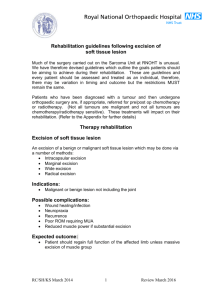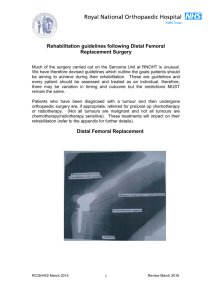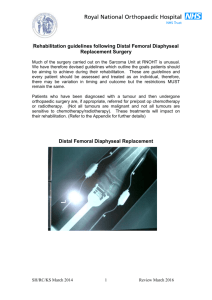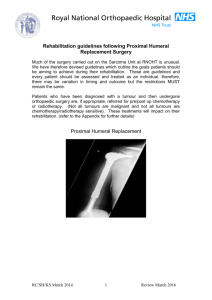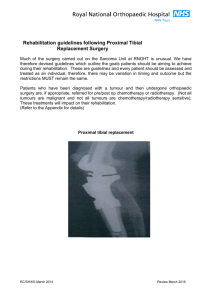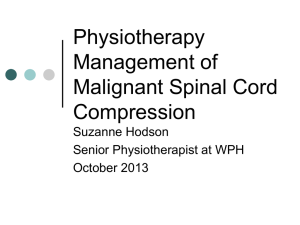Excision lesion of bone rehabilitation guidelines
advertisement
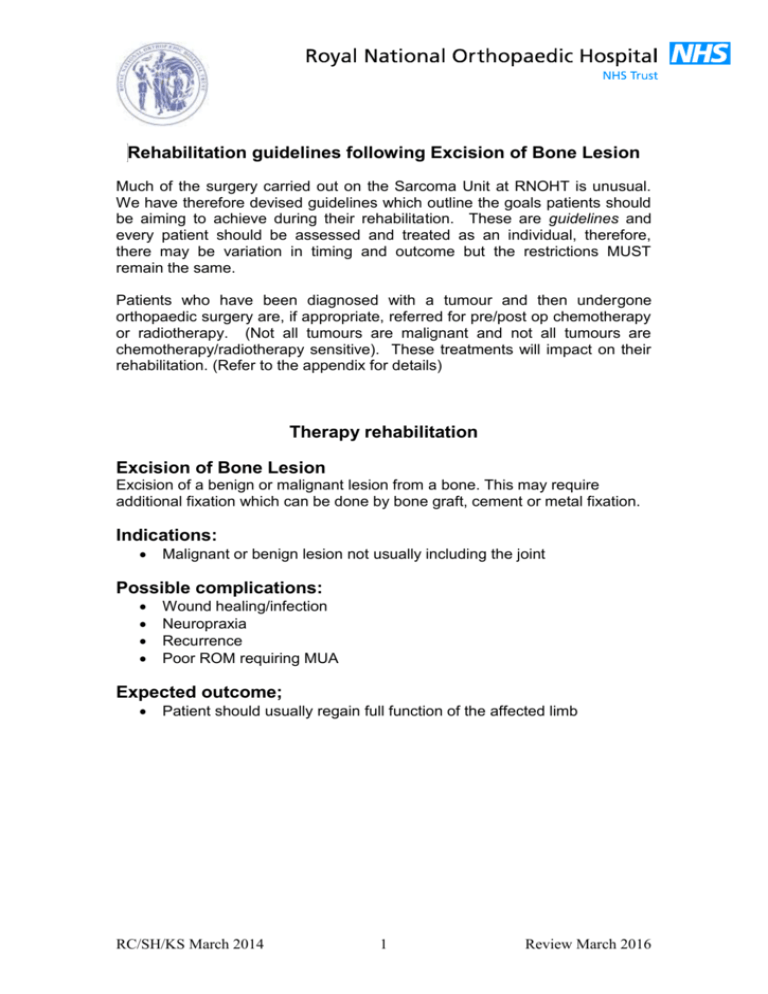
Rehabilitation guidelines following Excision of Bone Lesion Much of the surgery carried out on the Sarcoma Unit at RNOHT is unusual. We have therefore devised guidelines which outline the goals patients should be aiming to achieve during their rehabilitation. These are guidelines and every patient should be assessed and treated as an individual, therefore, there may be variation in timing and outcome but the restrictions MUST remain the same. Patients who have been diagnosed with a tumour and then undergone orthopaedic surgery are, if appropriate, referred for pre/post op chemotherapy or radiotherapy. (Not all tumours are malignant and not all tumours are chemotherapy/radiotherapy sensitive). These treatments will impact on their rehabilitation. (Refer to the appendix for details) Therapy rehabilitation Excision of Bone Lesion Excision of a benign or malignant lesion from a bone. This may require additional fixation which can be done by bone graft, cement or metal fixation. Indications: Malignant or benign lesion not usually including the joint Possible complications: Wound healing/infection Neuropraxia Recurrence Poor ROM requiring MUA Expected outcome; Patient should usually regain full function of the affected limb RC/SH/KS March 2014 1 Review March 2016 Initial rehabilitation phase Goals: Optimise tissue healing Ensure adequate pain control Patient to be independently mobile Range of movement within post operative limitations achieved Restrictions: Will be documented in post operative guidelines if applicable Orthotic appliances: Only if surgical procedure requires or if required following assessment by therapist Pain relief: Adequate analgesia, resting positions Patient education: Post operative restrictions, rehabilitation guidelines, how to donn and doff any orthotic appliances Physiotherapy rehabilitation: Static muscle strengthening and circulatory exercises commence from day 1. Aim for range of movement within post operative restrictions Mobilise with appropriate walking aid adhering to weight bearing status Practice stairs as appropriate Teach to donn and doff any orthotic appliances Prior to hospital discharge patients may require a referral for outpatient physiotherapy. If these patients are also going to receive chemotherapy or radiotherapy then a transfer summary must be sent to the centre that will be carrying out adjunctive therapy, Occupational Therapy Intervention Occupational Therapy is not routinely indicated, however, other members of the MDT may make referrals for any specific OT related problems that the patient may be experiencing. RC/SH/KS March 2014 2 Review March 2016 Final rehabilitation phase 12 weeks and beyond Goals: Return to function Orthotic appliances: Should no longer be required Patient education: Encourage return to normal function Physiotherapy rehabilitation - lower limb: Gait re-education Dynamic control/core stability Proprioception/balance work Return to full function Upper limb: AROM with good dynamic scapula control Scapula stability and core stability Proprioception/balance work Return to full function RC/SH/KS March 2014 3 Review March 2016 Appendix Some chemotherapy and radiotherapy side effects and implications for treatment: Bone marrow toxicity, ↓white cell count, ↓platelets, ↓Hb and ↓rate of healing. White cell count will be at its lowest approximately 10 days post chemotherapy and signs of wound infection should be watched for. Hydrotherapy should not be undertaken at this point Nausea, vomiting, diarrhoea, ↓appetite, lethargy and ↓exercise tolerance. Physiotherapy will be particularly important during and immediately after chemo and radiotherapy, as patients often lose ROM and strength after a cycle. Community physiotherapy may need to be arranged after discharge if the patient is too unwell to attend for outpatient treatment. The occupational therapist may need to advise on the practical implications of the symptoms such as meal and drink preparation, laundry and hygiene. Relaxation techniques may also be used to reduce nausea and vomiting in addition to reducing anxiety levels associated with food and meal times. Anxiety and depression – these can diminish people’s concentration, ability to assimilate information and motivation to carry out activities. The therapists, among other treatment, will identify goals which increase a person’s sense of control. Fatigue – needs to be addressed / acknowledged as it can affect a person’s physical and cognitive ability to carry out normal activities. The therapists will need to take this into consideration and tailor the rehabilitation accordingly. Anaemia which can lead to tiredness, lethargy and breathlessness Radiotherapy only: Fibrosis of soft tissues – Can continue for up to 2 years and may lead to contractures. Passive exercise is very important during and immediately post radiotherapy to prevent loss of ROM Demineralisation of bone – increases risk of fracture Redness, soreness and sensitivity of the skin to heat – care of the skin is important. Heat modalities are contraindicated post DXT. Application of lotions and manual treatments are contraindicated during DXT, but can be used with caution post DXT. Electrical modalities e.g. TNS and FES can be used with caution RC/SH/KS March 2014 4 Review March 2016
